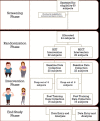Effectiveness of high-intensity interval training for weight loss in adults with obesity: a randomised controlled non-inferiority trial
- PMID: 34367654
- PMCID: PMC8292807
- DOI: 10.1136/bmjsem-2020-001021
Effectiveness of high-intensity interval training for weight loss in adults with obesity: a randomised controlled non-inferiority trial
Abstract
Introduction: Obesity treatment guidelines suggest moderate-intensity continuous training (MICT), but the patient's compliance to this indication remains low. High-intensity interval training (HIIT) is a time sparing training mode whose metabolic effects are not clear. This study aimed to determine whether a 12-week HIIT was more effective than MICT for weight loss in obese adults.
Methods: 44 obese subjects were randomised and trained with isoenergetic treadmill exercises for 12 weeks: MICT (60% of maximal oxygen peak, VO2peak) or HIIT (3-7 repetition of 3 min 100% of VO2peak interspersed by 1.5 min 50% of VO2peak). The primary outcome was a change in body weight; the secondary outcomes were changes in body composition, blood pressure, lipid profile, glycaemia, insulin and VO2peak.
Results: 32 subjects (53% male, mean age: 38.5 years, mean body mass index: 35.5 kg/m2) completed the trial. MICT and HIIT showed comparable effect within groups in weight loss (-6.0 kg (-9.0 kg to -3.0 kg) vs -5.7 kg (-8.3 kg to -3.1 kg)), changes in fat mass (-2.9% (-4.4% to -1.4%) vs -3.6% (-5.9% to -1.2%)), fat free mass (-5.3% (-7.8% to -2.8%) vs -5.5% (-8.3% to -2.6%)), diastolic blood pressure (-5.5 mm Hg (-10.6 mm Hg to -0.3 mm Hg) vs -5.8 mm Hg (-11.3 mm Hg to -0.3 mm Hg)) and low-density lipoprotein cholesterol (-16.4 mg/dL (-30.8 mg/dL to -2.0 mg/dL) vs -14.7 mg/dL (-25.6 mg/dL to -3.8 mg/dL)). There was a significant change between groups in VO2peak (HIIT: +461.6 mL (329.3‒593.8 mL); MICT: +170.5 mL (86.7-254.4 mL); p<0001) and duration of sessions (HIIT: 35.0 min (31.7 ‒35.6 min); MICT: 46.5 min (40.2‒48.3 min); p<0.001). No significant changes in systolic blood pressure, high-density lipoprotein cholesterol, triglycerides, glycaemia or plasma insulin were observed.
Conclusions: In healthy adults with obesity, HIIT compared with MICT induced similar weight loss and cardiovascular risk factors improvement but resulted in a larger increase in cardiorespiratory fitness over a shorter period.
Keywords: aerobic fitness; body composition; metabolism; obesity.
© Author(s) (or their employer(s)) 2021. Re-use permitted under CC BY-NC. No commercial re-use. See rights and permissions. Published by BMJ.
Conflict of interest statement
Competing interests: None declared.
Figures
Similar articles
-
Comparison of the effects of high-intensity interval and moderate-intensity continuous training on inflammatory markers, cardiorespiratory fitness, and quality of life in breast cancer patients.J Sport Health Sci. 2023 Nov;12(6):674-689. doi: 10.1016/j.jshs.2023.07.001. Epub 2023 Jul 8. J Sport Health Sci. 2023. PMID: 37423313 Free PMC article. Clinical Trial.
-
Effect of High-Intensity Interval Training and Moderate-Intensity Continuous Training in People With Poststroke Gait Dysfunction: A Randomized Clinical Trial.J Am Heart Assoc. 2023 Nov 21;12(22):e031532. doi: 10.1161/JAHA.123.031532. Epub 2023 Nov 10. J Am Heart Assoc. 2023. PMID: 37947080 Free PMC article. Clinical Trial.
-
Comparative Effectiveness of High-Intensity Interval Training and Moderate-Intensity Continuous Training for Cardiometabolic Risk Factors and Cardiorespiratory Fitness in Childhood Obesity: A Meta-Analysis of Randomized Controlled Trials.Front Physiol. 2020 Apr 3;11:214. doi: 10.3389/fphys.2020.00214. eCollection 2020. Front Physiol. 2020. PMID: 32308627 Free PMC article.
-
The Effect of Low-Volume High-Intensity Interval Training on Body Composition and Cardiorespiratory Fitness: A Systematic Review and Meta-Analysis.Sports Med. 2019 Nov;49(11):1687-1721. doi: 10.1007/s40279-019-01167-w. Sports Med. 2019. PMID: 31401727
-
Is isoenergetic high-intensity interval exercise superior to moderate-intensity continuous exercise for cardiometabolic risk factors in individuals with type 2 diabetes mellitus? A single-blinded randomized controlled study.Eur J Sport Sci. 2023 Oct;23(10):2086-2097. doi: 10.1080/17461391.2023.2167238. Epub 2023 Feb 5. Eur J Sport Sci. 2023. PMID: 36622777 Clinical Trial.
Cited by
-
Experimental research of impact on psychological state for adolescents with high-intensity interval training intervention.Front Psychol. 2025 May 9;16:1567003. doi: 10.3389/fpsyg.2025.1567003. eCollection 2025. Front Psychol. 2025. PMID: 40417018 Free PMC article.
-
Maintenance of time-restricted eating and high-intensity interval training in women with overweight/obesity 2 years after a randomized controlled trial.Sci Rep. 2025 Apr 25;15(1):14520. doi: 10.1038/s41598-025-95743-y. Sci Rep. 2025. PMID: 40280987 Free PMC article.
-
Skeletal Muscle Mitochondrial and Perilipin Content in a Cohort of Obese Subjects Undergoing Moderate and High Intensity Training.Metabolites. 2022 Sep 11;12(9):855. doi: 10.3390/metabo12090855. Metabolites. 2022. PMID: 36144258 Free PMC article.
-
Exercise Training Program Improves Subjective Sleep Quality and Physical Fitness in Severely Obese Bad Sleepers.Int J Environ Res Public Health. 2022 Oct 22;19(21):13732. doi: 10.3390/ijerph192113732. Int J Environ Res Public Health. 2022. PMID: 36360611 Free PMC article.
-
The role of physical activity in obesity: let's actively manage obesity.Clin Med (Lond). 2023 Jul;23(4):311-317. doi: 10.7861/clinmed.2023-0152. Clin Med (Lond). 2023. PMID: 37524432 Free PMC article.
References
LinkOut - more resources
Full Text Sources

